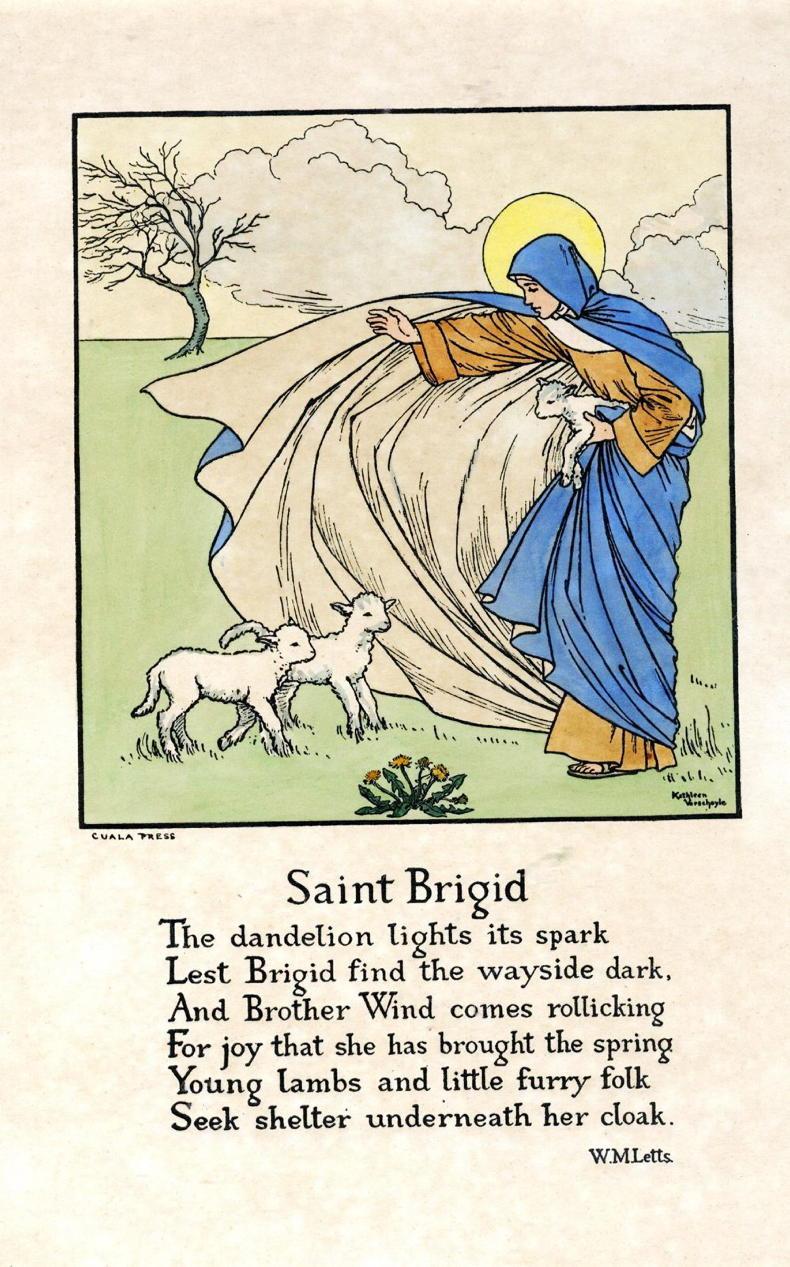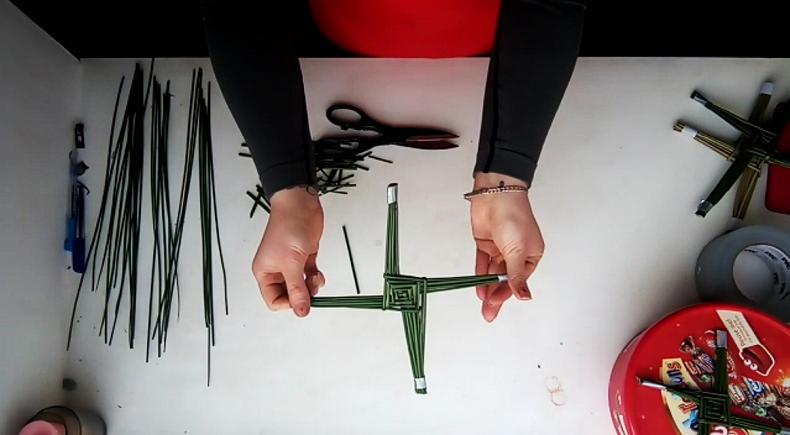On Monday, we celebrated St Brigid’s day, or Lá Fhéile Brigide in our native tongue.
Variations of the name are Bridget in English, Bríd in modern Irish.
Did you know that Ireland has three patron saints?
We all know about Patrick but Colmcille is another, while Brigid is the third.
The feast day of St Brigid, on 1 February, coincides with a time of the year when we feel that brighter days are on the horizon.
Crosses made from rushes were given her name, while in parts of the country people carried small dolls called brídeogs from house to house on her feast day as they sought alms.
However, it is not only in Ireland, and specifically Kildare, that Brigid is remembered and celebrated.
Vikings
In 835, the Vikings destroyed her shrine in Kildare, but tradition has it that her remains had already been taken to Co Down and buried along with Saints Patrick and Colmcille.
Meanwhile, travelling monks brought her story to Europe, and her feast day was actually celebrated in Germany.
Some of the tales of Brigid have been questioned by historians
Bruges in Belgium is home to a cloth, said to be Brigid’s mantle, while, more bizarrely, her head is allegedly in a church near Lisbon.
Some of the tales of Brigid have been questioned by historians, and may in fact relate to a Celtic goddess of agriculture and poetry, an interesting mix, also called Brigid.
One such tale is that the earlier Brigid hung her cloak, for which the saint became famous, to dry on a sunbeam.
Much more likely to have happened was that St Brigid took a costly set of vestments from Conleth, who had brought them from the continent.
Brigid showed her charitable nature by cutting the vestments up to give strips of cloth to the impoverished. That story would sit better with the Christian view of the saint, as did her power to cure lepers.
Brigid in art
Though Brigid was celebrated in terms of art, we don’t see too many examples today.
For me there is one image, a more modern one even it was from a century ago, that encapsulates much of what we believe we know about the saint.

St Brigid.
This is a poster, known as a broadside, which was issued by The Cuala Press in Dublin.
The image reflects Brigid’s association with the start of spring and the lambing season and was a collaborative work between two women, the English poet Winifred Mary Letts, who spent most of her life in Ireland, and the Irish artist Kathleen Verschoyle.
It is noteworthy that it was published by The Cuala Press, which was established in 1908 by Elizabeth Yeats.
You will not be surprised to learn that she was a sister of the poet WB Yeats and the painter Jack B Yeats.
The company published books and prints by Irish authors and artists and was run and staffed exclusively by women.
National holiday
There have been some calls that 1 February should be a national holiday to honour our only female patron saint.
Perhaps it should be considered, as little enough is done to make it a day of celebration.
This year, the Museum of Literature Ireland, with the Department of Foreign Affairs, has released a series of three short online films, Three Poems for Brigid.
Each film showcases a poet and a spoken word performer, and is based around one of the three aspects of Brigid as the goddess of poetry, healing and craftwork.
The works were commissioned from three of Ireland’s finest female poets, Doireann Ní Ghríofa, Paula Meehan and Nidhi Zak/Aria Eipe.
The films are available to view here.
Read more
Watch: how to make a St Brigid's Day cross
Podcast: Have you ever heard of the Biddie?
On Monday, we celebrated St Brigid’s day, or Lá Fhéile Brigide in our native tongue.
Variations of the name are Bridget in English, Bríd in modern Irish.
Did you know that Ireland has three patron saints?
We all know about Patrick but Colmcille is another, while Brigid is the third.
The feast day of St Brigid, on 1 February, coincides with a time of the year when we feel that brighter days are on the horizon.
Crosses made from rushes were given her name, while in parts of the country people carried small dolls called brídeogs from house to house on her feast day as they sought alms.
However, it is not only in Ireland, and specifically Kildare, that Brigid is remembered and celebrated.
Vikings
In 835, the Vikings destroyed her shrine in Kildare, but tradition has it that her remains had already been taken to Co Down and buried along with Saints Patrick and Colmcille.
Meanwhile, travelling monks brought her story to Europe, and her feast day was actually celebrated in Germany.
Some of the tales of Brigid have been questioned by historians
Bruges in Belgium is home to a cloth, said to be Brigid’s mantle, while, more bizarrely, her head is allegedly in a church near Lisbon.
Some of the tales of Brigid have been questioned by historians, and may in fact relate to a Celtic goddess of agriculture and poetry, an interesting mix, also called Brigid.
One such tale is that the earlier Brigid hung her cloak, for which the saint became famous, to dry on a sunbeam.
Much more likely to have happened was that St Brigid took a costly set of vestments from Conleth, who had brought them from the continent.
Brigid showed her charitable nature by cutting the vestments up to give strips of cloth to the impoverished. That story would sit better with the Christian view of the saint, as did her power to cure lepers.
Brigid in art
Though Brigid was celebrated in terms of art, we don’t see too many examples today.
For me there is one image, a more modern one even it was from a century ago, that encapsulates much of what we believe we know about the saint.

St Brigid.
This is a poster, known as a broadside, which was issued by The Cuala Press in Dublin.
The image reflects Brigid’s association with the start of spring and the lambing season and was a collaborative work between two women, the English poet Winifred Mary Letts, who spent most of her life in Ireland, and the Irish artist Kathleen Verschoyle.
It is noteworthy that it was published by The Cuala Press, which was established in 1908 by Elizabeth Yeats.
You will not be surprised to learn that she was a sister of the poet WB Yeats and the painter Jack B Yeats.
The company published books and prints by Irish authors and artists and was run and staffed exclusively by women.
National holiday
There have been some calls that 1 February should be a national holiday to honour our only female patron saint.
Perhaps it should be considered, as little enough is done to make it a day of celebration.
This year, the Museum of Literature Ireland, with the Department of Foreign Affairs, has released a series of three short online films, Three Poems for Brigid.
Each film showcases a poet and a spoken word performer, and is based around one of the three aspects of Brigid as the goddess of poetry, healing and craftwork.
The works were commissioned from three of Ireland’s finest female poets, Doireann Ní Ghríofa, Paula Meehan and Nidhi Zak/Aria Eipe.
The films are available to view here.
Read more
Watch: how to make a St Brigid's Day cross
Podcast: Have you ever heard of the Biddie?







 This is a subscriber-only article
This is a subscriber-only article










SHARING OPTIONS: